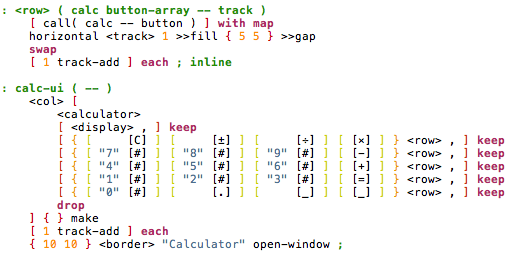Most of the software I work with is very practical. At Oasis Digital we mostly create line-of-business enterprise software, and even when I step away from that, I usually pick up a tool or language that has a good likelihood of mainsteam adoption.

Sometimes, though, I like to really stretch my mind. For that, it’s hard to beat Factor. Factor is fascinating in that it combines a goal of efficiency and practicality, with a syntax and computation model which are quite alien even to a software polyglot. Don’t let the stack-ness deceive you; it’s a big leap even if you’ve used FORTH and grown up with a HP RPN programmable calculator.
So I set about this evening to work with some Factor code, a simple GUI calculator posted a few days ago by John Benediktsson. I bit off an apparently small bit of work: remove the “code smell” of that global variable, and in the process, make it so multiple calcs each have their own model (rather than a global shared state).
The two most important pieces of updated code:

The changes consist approximately of:
- Change all the button words to accept a model input
- Change the <row> word to accept a model and use map instead of output>array
- Remove the calc variable
- Change the calc-ui word to shuffle things around and use make rather than output>array
In case it isn’t obvious from my text above or the source code, I am not a Factor programmer, please do not use this as example code. On the other, I learned a bunch of little things about Factor, and perhaps implicitly about concatenative programming in general, in the process of making this work.
